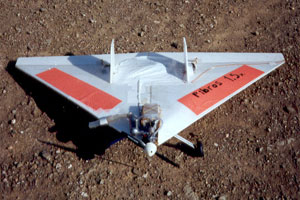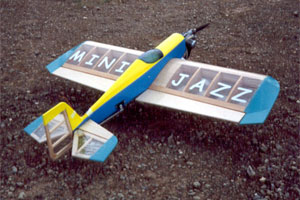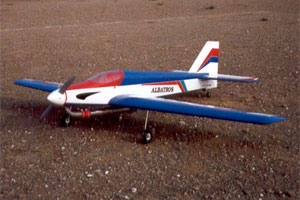| I
like everything that flies. On the other hand, I like to
keep my feet on the ground… But I am not just an
"armchair aviator": I like to make things fly.
I have built paper airplanes, kites, boomerangs, and R/C
airplanes. My main hobby is to design, build and fly radio controlled (R/C) airplanes. It is a very complete technical hobby, because it deals with lots of different aspects: from the most theoretical ones (aerodynamics, material resistance,...) to the hands-on construction and operation of the airplane. In fact, the design of a model airplane follows the same structure as any other product development process. I particularly like to design planes that fall out of the ordinary, in terms of shape, materials or flight behaviour (or all at the same time!). Even when I build an existing design, I almost always finish modifying something, so that it suits better my needs. Trying new concepts, staying out of the tried-and-tested, means success is not guaranteed. Even though, all my planes have flown, and most of them have been the "Best of Show" at the exhibitions where I have taken part. |
| PIBROS |
 This small,
cool-looking glider is very easy and cheap to build, but
requires micro RC gear and a good slope, or it won't fly
better than the average paper airplane. In absence of
slope, it can be flown using catapult launching. Typical
flight time of 30 seconds. This small,
cool-looking glider is very easy and cheap to build, but
requires micro RC gear and a good slope, or it won't fly
better than the average paper airplane. In absence of
slope, it can be flown using catapult launching. Typical
flight time of 30 seconds. |
| PIBROS 1.5X |
 I built a pibros
delta slope glider, but it didn't fly well (it ended too
heavy and there was not enough wind on the slope). Then I
thought of building a 50% bigger version (hence the
name), and power it with a .10 engine. It worked
extremely well. Excellent high and low speed behaviour,
and very manoeuvrable. It is also extremely quiet (I
guess because of its all-foam construction). I built a pibros
delta slope glider, but it didn't fly well (it ended too
heavy and there was not enough wind on the slope). Then I
thought of building a 50% bigger version (hence the
name), and power it with a .10 engine. It worked
extremely well. Excellent high and low speed behaviour,
and very manoeuvrable. It is also extremely quiet (I
guess because of its all-foam construction).During a festival, I had a mid-air, and it was able to land with only one fin. The same day, this was the only plane to cut the streamer on the foxhunt. After this success, I installed a .25 engine and +/- 45 deg deflection on control surfaces. Result was half a roll and smash into the ground just after hand launch. |
| DIE HARD |
 An ultra simple
foamie glider. Wing is hot-wire cut from expanded
polystyrene and covered with parcel tape. Control horns
are bent bits of credit card, and pushrods are made out
of bicycle wheel radius. I built it in an afternoon, the
day before the club's annual trip to the slope. An ultra simple
foamie glider. Wing is hot-wire cut from expanded
polystyrene and covered with parcel tape. Control horns
are bent bits of credit card, and pushrods are made out
of bicycle wheel radius. I built it in an afternoon, the
day before the club's annual trip to the slope.It showed poor penetration (because of the thick, draggy wing), but as a result it could remain static on the sky. Lots of fun keeping it just in front of me like a helicopter. |
| MINI JAZZ |
 Mini Jazz is built
from a plan that appeared on the English magazine
RCM&E. With its light weight and huge control
surfaces, it is capable of the wildest aerobatics. Its
wing can be detached for easier transport and storage,
making it an ideal plane for summer holidays. Mini Jazz is built
from a plan that appeared on the English magazine
RCM&E. With its light weight and huge control
surfaces, it is capable of the wildest aerobatics. Its
wing can be detached for easier transport and storage,
making it an ideal plane for summer holidays. |
| JAZZ |
 After the success of
the Mini Jazz, I upscaled it to suit a 7.5cc engine. I
wanted to practice hover, so the plane should be light
and cheap! It is built mainly from Depron, and was the
first plane in my club field capable of sustaining hover. After the success of
the Mini Jazz, I upscaled it to suit a 7.5cc engine. I
wanted to practice hover, so the plane should be light
and cheap! It is built mainly from Depron, and was the
first plane in my club field capable of sustaining hover. |
| TUBE |
 Fuselage from PVC
pipe (hence the name); wings and tail surfaces from
alveolar plastic panel (known as coroplast or correx). It
is a bit heavy and has very bad spin behaviour, but is
indestructible. Once I couldn't recover from a spin and
crashed from 20m height; the only damage was a bent
landing gear! Fuselage from PVC
pipe (hence the name); wings and tail surfaces from
alveolar plastic panel (known as coroplast or correx). It
is a bit heavy and has very bad spin behaviour, but is
indestructible. Once I couldn't recover from a spin and
crashed from 20m height; the only damage was a bent
landing gear! |
| ALBATROS |
 This is a ready to
fly kit. It flies as if on rails. Good starting point for
precision (pattern) aerobatics. This is a ready to
fly kit. It flies as if on rails. Good starting point for
precision (pattern) aerobatics. |
| SOUCOUPE Modèle Mag |
 I have built several
circular wing airplanes. First of all was the
"soucoupe Modèle Mag", a free plan of the
French magazine (#month, year). Very light, capable of
extremely slow flight and static loops (like tumbles). On
the other hand, roll response was very slow. Was
destructed on a high-G manoeuvre after a power dive
(pilot error...) I have built several
circular wing airplanes. First of all was the
"soucoupe Modèle Mag", a free plan of the
French magazine (#month, year). Very light, capable of
extremely slow flight and static loops (like tumbles). On
the other hand, roll response was very slow. Was
destructed on a high-G manoeuvre after a power dive
(pilot error...) |
| DRENALYN |
 After my first
incursion in "flying saucer" planes, I came
across Drénalyn, a model designed for electric indoor
flight. It retains the same concept, but has a
"D" shape instead of an "O" shape.
This allows for broader control surfaces, and so better
roll response. I saw three of this planes fly together
inside a cage on Salon Maquette 2001 in Paris, and its
manoeuvrability and stable hover are incredible. I built
a .10-powered version, for outdoor use, and can be flown
from any field, no matter how small. Perfect for
exhibitions on football fields. After my first
incursion in "flying saucer" planes, I came
across Drénalyn, a model designed for electric indoor
flight. It retains the same concept, but has a
"D" shape instead of an "O" shape.
This allows for broader control surfaces, and so better
roll response. I saw three of this planes fly together
inside a cage on Salon Maquette 2001 in Paris, and its
manoeuvrability and stable hover are incredible. I built
a .10-powered version, for outdoor use, and can be flown
from any field, no matter how small. Perfect for
exhibitions on football fields.UPDATE: I installed a .15 engine on my Drénalyn, and now it is capable of impressive vertical climbs! I have also added rudder to improve control while in hover. Because of its small size and light weight, it is quite twitchy, but nevertheless is an excellent airplane to practice hover. |
| DORAEMON |
 After the success of
the formula, I designed a flying Doraemon (a popular
Japanese cartoon character), with his flying helmet. Fin
is transparent, and control surfaces are the feet of
Doraemon. This plane is really cool on flight! It was
"Best of Show" at Amposta #1999 R/C air show. After the success of
the formula, I designed a flying Doraemon (a popular
Japanese cartoon character), with his flying helmet. Fin
is transparent, and control surfaces are the feet of
Doraemon. This plane is really cool on flight! It was
"Best of Show" at Amposta #1999 R/C air show. |
| RACER |
 This was a R&D
project on my last year in High School. I received an
award from Generalitat de Catalunya for this project. This was a R&D
project on my last year in High School. I received an
award from Generalitat de Catalunya for this project.This plane is designed for Club 20 pylon racing, a competition in which planes have to fly 10 laps around three pylons in the shortest time. It is aerodynamically optimised for high speed, while respecting Club 20 rules. For cost and schedule reasons, I only built a full-size polystyrene mock-up. To have a flying model, I would have had to cover it with carbon fibre and epoxy, which is quite costly even for such a small plane. Tight schedule was also a limiting factor... |
| P-40 |
 1/12 scale warbird,
designed for Aircombat, a competition in which up to six
planes tow a paper streamer and have to cut the others'
streamers. Very exciting, but very unpopular at my club
because of fear to crash. In fact, I am the only one that
owns one of this kind of planes, so for the time being it
has been impossible to have a real combat. 1/12 scale warbird,
designed for Aircombat, a competition in which up to six
planes tow a paper streamer and have to cut the others'
streamers. Very exciting, but very unpopular at my club
because of fear to crash. In fact, I am the only one that
owns one of this kind of planes, so for the time being it
has been impossible to have a real combat. |
| ESCUELA |
 The first radio
control plane I flew. My father bought it when I was ##.
A very pleasant glider trainer, very popular in Spain.
The name means "school" in Spanish. The first radio
control plane I flew. My father bought it when I was ##.
A very pleasant glider trainer, very popular in Spain.
The name means "school" in Spanish. |
| DELTA-1 |
 My first serious
attempt at building an all-foam plane. It was built
during holydays, on a small town far from specialised
shops. Wing is 30mm thick expanded polystyrene, cut to
shape with cutter, covered with kraft paper and wallpaper
paste, and painted with household enamel. As you can see,
no R/C specific material! My first serious
attempt at building an all-foam plane. It was built
during holydays, on a small town far from specialised
shops. Wing is 30mm thick expanded polystyrene, cut to
shape with cutter, covered with kraft paper and wallpaper
paste, and painted with household enamel. As you can see,
no R/C specific material!Flies very well, maybe because of the square leading edge. This plane is almost unbreakable: it has survived a vertical deadstick landing (Harrier style), a belly smash to the ground when trying to do a fast low pass, and (incredible but true) a crash with one of the limbo poles (2cm square spruce). The main problem is transporting and storing this 1.2x1.2m plane. |